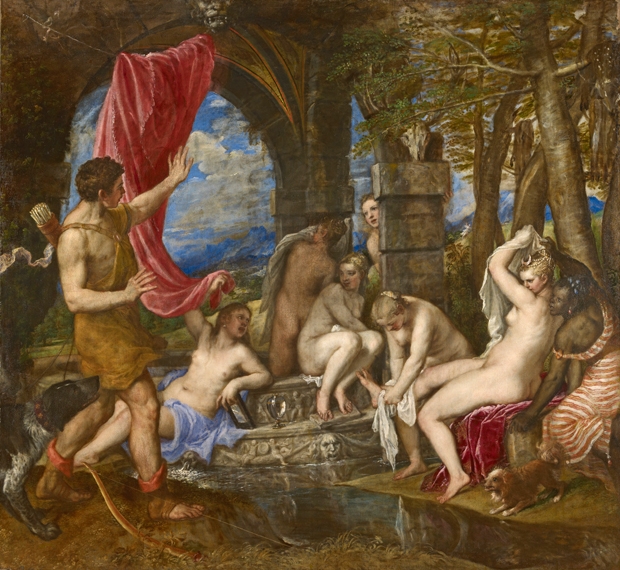In Venice, around 1552, Titian began work on a series of six paintings for King Philip II of Spain, each of which reinterpreted a scene from Ovid’s Metamorphoses. The resulting work proved to be the apogee of his career and became what may be the most influential group of paintings in post-Renaissance European art. Studied, absorbed and channelled by successive generations of artists, from Velázquez and Rubens through to Gainsborough and latterly Freud, the impact of these works and their stylistic legacy was profound.
Three of these paintings, ‘Diana and Actaeon’, ‘Diana and Callisto’ and ‘The Death of Actaeon’ are now on display in Edinburgh in the new exhibition at the National Galleries of Scotland, Titian and the Golden Age of Venetian Art. The first two are, after a long fundraising campaign, now jointly owned by the National Galleries in Edinburgh and London, while ‘The Death of Actaeon’ makes its first foray outside London since 1972. It is quite a collection.

This exhibition hangs the three masterpieces together and demonstrates emphatically why Titian was regarded as the greatest artist of his time and why his influence was so immense. Context for the work is offered by other paintings in the show, three earlier Titians flanked by work from notable contemporaries — Lorenzo Lotto, Paris Bordone, Jacopo Bassano, Tintoretto. There’s a handsome Veronese by the door and a room of drawings and prints too, including a fluid figurative chalk on paper, acquired by the gallery in 2007 and recently confirmed as a Titian.
Tintoretto trained briefly in Titian’s workshop — legend has it that he was expelled for caricaturing the master; certainly a mutual dislike emerged. His ‘Christ Carried into the Tomb’ is an eerie scene, the dead Christ grey of skin and long of body. Its Mannerist distortions, seen with peculiar perspective, are rendered with a vivacious handling of the paint that relates to Titian’s later work. The Bassano and Bordone paintings, on the other hand, stand as a counterpoint to the mythological ‘Poesies’. Bordone’s approach is fussier: fiddly, relying on intricacy and sharp chromatic contrasts. Bassano, too, is a painter of precise and ordered design; ‘The Adoration of the Magi’ lacks the fluid brushwork and dramatic flow of Titian’s mythological scenes. The presence of these paintings serves to heighten understanding of what Titian achieved in his late works. The stylistic contrast can be seen immediately the viewer turns from these static compositions on one side of the gallery to the vivid energy of the late Titians on the other.

The earlier Titians displayed here correspond as much with the rigid geometry of Lotto’s beautiful and serene ‘Virgin and Child with Saints’ as with his own later pieces. Titian’s version of the same subject is presented within a stage set of static scenery and, like the Lotto, can be dissected into solid colour segments. The intensity of the hues obtained from these early pigments remains astonishing, but it lacks the chromatic complexity and compositional dynamism of the later work. The light is uniform, not dappled by trees and reflections; the brush does not dance across the surface.
What a rare treat it is to see half of the original mythological ‘Poesies’ together. ‘Diana and Actaeon’ and ‘Diana and Callisto’ function as a pair, with a compositional continuity stretching from Actaeon, on the left of his painting, all the way across to Diana, busy expelling an agonised Callisto from the right-hand side of that work. The structure encourages the viewer to read each painting from left to right, following the action of the story. The composition, the light, the flow of warm hues against cool, reveals the narrative like a graphic strip.
So, Actaeon lifts the curtain, embarrasses the corpulent nymphs and angers Diana, her expression that of unconcealed fury. So too does the fate of wretched Callisto unfold as we see her backing into the shadows, trying to conceal her pregnant state from Diana, who throws out a banishing finger of scorn.
‘The Death of Actaeon’ marks yet more progression. Darker in palette and even looser in handling, this is a modern painting. Again, the scenery conspires with the figures, the vigorous brushwork and the cast of light to direct the drama. Diana’s bow leads us to the cursed Actaeon as he is brought down by his own hounds. It is a violent, tragic and inventive painting, played out beneath a thunderous sky that comes straight from nature.
The indulgent patronage of Philip II allowed Titian unprecedented freedom to experiment, encouraging the creative ambition that unleashed these remarkable figures, their expressions as vital as their flesh and the landscape around them. These paintings represent a pivotal point in the development of European art, and to stand before them now, as Velázquez and so many others have done before, is truly a privilege.






Comments